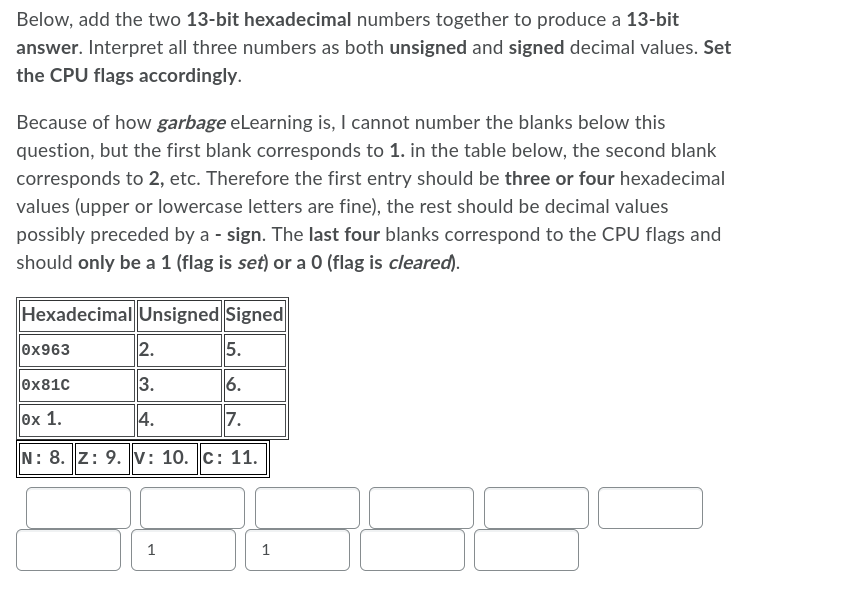Below, add the two 13-bit hexadecimal numbers together to produce a 13-bit answer. Interpret all three numbers as both unsigned and signed decimal values. Set the CPU flags accordingly. Because of how garbage eLearning is, I cannot number the blanks below this question, but the first blank corresponds to 1. in the table below, the second blank corresponds to 2, etc. Therefore the first entry should be three or four hexadecimal values (upper or lowercase letters are fine), the rest should be decimal values possibly preceded by a - sign. The last four blanks correspond to the CPU flags and should only be a 1 (flag is set) or a 0 (flag is cleared).
Below, add the two 13-bit hexadecimal numbers together to produce a 13-bit answer. Interpret all three numbers as both unsigned and signed decimal values. Set the CPU flags accordingly. Because of how garbage eLearning is, I cannot number the blanks below this question, but the first blank corresponds to 1. in the table below, the second blank corresponds to 2, etc. Therefore the first entry should be three or four hexadecimal values (upper or lowercase letters are fine), the rest should be decimal values possibly preceded by a - sign. The last four blanks correspond to the CPU flags and should only be a 1 (flag is set) or a 0 (flag is cleared).
Computer Networking: A Top-Down Approach (7th Edition)
7th Edition
ISBN:9780133594140
Author:James Kurose, Keith Ross
Publisher:James Kurose, Keith Ross
Chapter1: Computer Networks And The Internet
Section: Chapter Questions
Problem R1RQ: What is the difference between a host and an end system? List several different types of end...
Related questions
Question
Can someone help me with this?

Transcribed Image Text:Below, add the two 13-bit hexadecimal numbers together to produce a 13-bit
answer. Interpret all three numbers as both unsigned and signed decimal values. Set
the CPU flags accordingly.
Because of how garbage eLearning is, I cannot number the blanks below this
question, but the first blank corresponds to 1. in the table below, the second blank
corresponds to 2, etc. Therefore the first entry should be three or four hexadecimal
values (upper or lowercase letters are fine), the rest should be decimal values
possibly preceded by a sign. The last four blanks correspond to the CPU flags and
should only be a 1 (flag is set) or a 0 (flag is cleared).
Hexadecimal Unsigned Signed
0x963
2.
5.
0x81c
3.
6.
ex 1.
4.
7.
N: 8. Z: 9.v: 10. c: 11.
1
1
Expert Solution
This question has been solved!
Explore an expertly crafted, step-by-step solution for a thorough understanding of key concepts.
This is a popular solution!
Trending now
This is a popular solution!
Step by step
Solved in 2 steps with 1 images

Recommended textbooks for you

Computer Networking: A Top-Down Approach (7th Edi…
Computer Engineering
ISBN:
9780133594140
Author:
James Kurose, Keith Ross
Publisher:
PEARSON

Computer Organization and Design MIPS Edition, Fi…
Computer Engineering
ISBN:
9780124077263
Author:
David A. Patterson, John L. Hennessy
Publisher:
Elsevier Science

Network+ Guide to Networks (MindTap Course List)
Computer Engineering
ISBN:
9781337569330
Author:
Jill West, Tamara Dean, Jean Andrews
Publisher:
Cengage Learning

Computer Networking: A Top-Down Approach (7th Edi…
Computer Engineering
ISBN:
9780133594140
Author:
James Kurose, Keith Ross
Publisher:
PEARSON

Computer Organization and Design MIPS Edition, Fi…
Computer Engineering
ISBN:
9780124077263
Author:
David A. Patterson, John L. Hennessy
Publisher:
Elsevier Science

Network+ Guide to Networks (MindTap Course List)
Computer Engineering
ISBN:
9781337569330
Author:
Jill West, Tamara Dean, Jean Andrews
Publisher:
Cengage Learning

Concepts of Database Management
Computer Engineering
ISBN:
9781337093422
Author:
Joy L. Starks, Philip J. Pratt, Mary Z. Last
Publisher:
Cengage Learning

Prelude to Programming
Computer Engineering
ISBN:
9780133750423
Author:
VENIT, Stewart
Publisher:
Pearson Education

Sc Business Data Communications and Networking, T…
Computer Engineering
ISBN:
9781119368830
Author:
FITZGERALD
Publisher:
WILEY